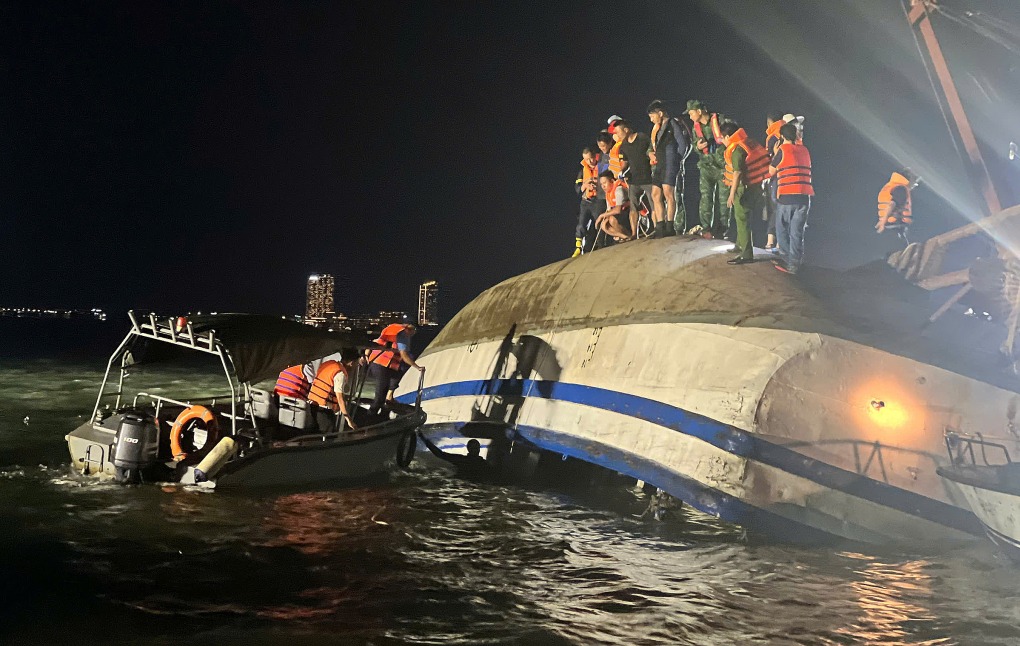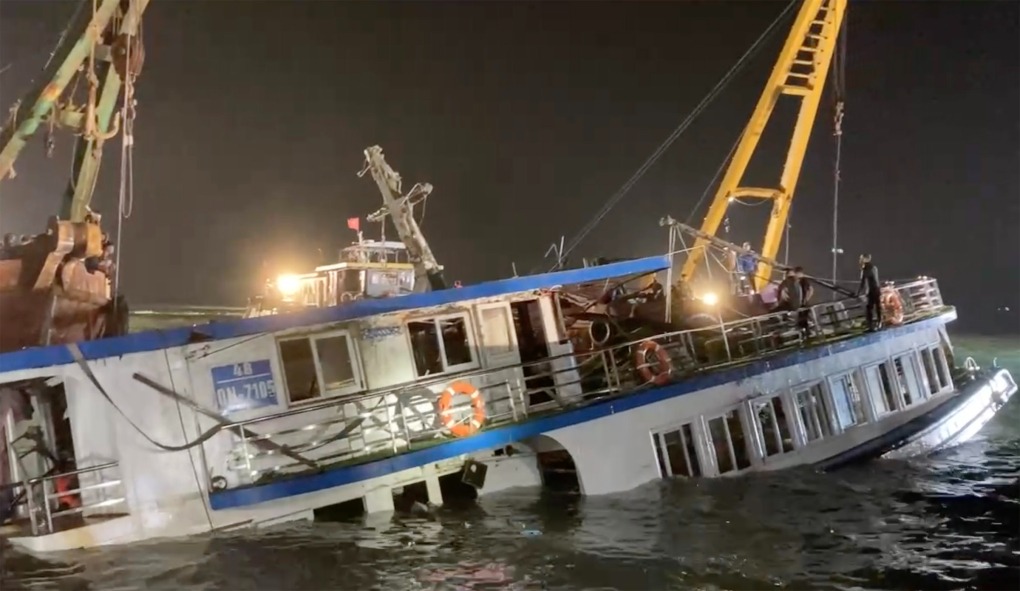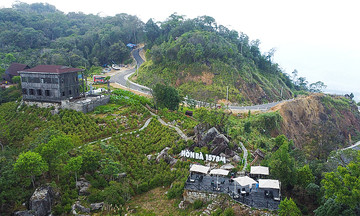In response to VnExpress on 22/7, a representative of the Quang Ninh Provincial Inland Waterways Port Authority and Inland Waterway Vehicle Registration (IWPA) said that tourist boats operating on the bay are monitored using GPS technology invested in since 2010. This system provides information such as location, speed, operating time, length of stay, itinerary, sightseeing spots, overnight locations, number of passengers, and number of crew and service staff.
This system also supports monitoring vessels at storm shelters and overnight accommodations, serving the IWPA's control and management of tourist boat activities on Ha Long bay.
The system's management process includes regular monitoring and handling violations based on the number of tourist boats on Ha Long bay. The IWPA has also established a six-person GPS team, divided into three shifts, working around the clock.
 |
Authorities overturned the Vinh Xanh to search for victims, the night of 19/7. Photo: Xuan Hoa |
Authorities overturned the Vinh Xanh to search for victims, the night of 19/7. Photo: Xuan Hoa
According to the draft planning to 2025, Quang Ninh maintains no more than 520 tourist boats on Ha Long bay, excluding luxury cruise ships. The addition of new boats is controlled according to tourism capacity and port infrastructure.
Some boat owners said that wave conditions on the bay are sometimes unfavorable, and temporary signal loss can occur, making it difficult for management units to track them. The IWPA representative also shared that the GPS monitoring system, invested in since 2010, has not been updated with new technologies, so many procedures must be performed manually. The mountainous terrain of Ha Long bay often leads to boats losing GPS signals, requiring time-consuming verification and reducing efficiency.
According to Decision No. 50/2022/QD-UBND dated 30/12/2022 of the provincial People's Committee (PPC), there is no specific regulation on how long after a ship loses signal it is considered missing or experiencing an incident.
The IWPA representative stated that, according to regulations, crew members must regularly check the technical condition of systems, especially fire prevention, anti-sinking, and communication systems, and ensure that the tracking device operates continuously and stably. When the tracking signal is lost, the captain must actively inform the IWPA of the vessel's location.
When a vessel's GPS signal is lost, monitoring staff will coordinate with the IWPA to verify the situation by contacting the captain or owner to check the vessel's status and the cause of the signal loss. They will request regular reports or contact nearby vessels to indirectly verify the vessel's location and condition. If contact cannot be established, a boat will be dispatched to the location of the lost signal for direct inspection.
Speaking to the press on the afternoon of 20/7, Bui Hong Minh, Deputy Director of the Quang Ninh Department of Construction, affirmed that according to local regulations, tourist boats on Ha Long bay must meet higher safety standards than the national standards, and in reality, 100% of boats have achieved this. The Vinh Xanh 58 has a stability safety factor of 2.3 (the standard is 1).
While the vessel is designed to exceed standards, in the event of an incident and GPS disconnection, it cannot transmit an automatic distress signal. Dr. Pham Ha, CEO of Lux Group, which owns a chain of luxury yachts in Nha Trang and Lan Ha, explained that when the GPS signal is lost, the captain has two other ways to alert management: via radio or by pressing the AIS button near the helm. If an unexpected incident occurs and the captain or crew cannot react in time, there is no automatic warning mechanism. This is a loophole in tourist boat design.
What needs to be improved?
Lux Group representative Pham Ha believes it's "time to move beyond safety as a slogan" and take action through technology, regulations, and standards. Vietnam, with over 3,200 km of coastline and thousands of beautiful islands and bays, is an attractive destination for marine tourism but also prone to natural disasters such as storms and gales. Therefore, early and accurate weather forecasting is crucial.
"Forecasts must not only be accurate but also timely and location-specific," Ha said.
 |
The Vinh Xanh was towed ashore and overturned in the early morning of 20/7. Photo: Navy |
The Vinh Xanh was towed ashore and overturned in the early morning of 20/7. Photo: Navy
When a vessel has left port and the weather changes suddenly, periodic bulletins every six hours are insufficient. Vietnam needs a real-time marine forecasting system using coastal radar technology, wave buoys, satellite data, and artificial intelligence (AI) to simulate and warn specific areas. Information must be internationally standardized, easy to understand, and transmitted across multiple platforms – from mobile applications and VHF radio to onboard displays.
Ha proposed setting separate wind and wave thresholds for different types of vessels; when exceeded, operations must cease. Authorities should also implement a safety rating system for tourist boats, publicly disclosing technical records, maintenance logs, and crew training schedules.
To achieve this, Ha believes a revolution in marine tourism management is needed, with a comprehensive digital platform for electronic dispatching and command; managing passengers with QR codes for identification and real-time monitoring of boarding/disembarking numbers, nationalities, and times. Vessels should have online GPS tracking integrated with radar systems, digital maps, and bay surveillance cameras. Data from departing vessels should be shared between the IWPA, border guards, businesses, meteorological centers, and rescue coordination centers.
Since April 2025, following a merger, the Quang Ninh Department of Construction has been researching new software for managing and regulating inland waterway transport in the province.
Some advantages of the new software include upgraded automatic warning features, sending requests to captains, sharing warning data with relevant authorities, upgrading GPS equipment, and proposing additional internet relay stations in the bay. The Department of Construction is also contacting experts to help build a system to warn of sudden thunderstorms in Ha Long, Bai Tu Long, and Co To bays to serve tourism and inland waterway transport in the province.
Nguyen Ngoc Bich, CEO of Rustic Hospitality Group, a company specializing in community tourism, believes that accidents can happen not only on adventurous journeys but even while sightseeing on Ha Long bay, rowing basket boats in Hoi An, or diving in Phu Quoc. Tourists need to seriously receive and practice pre-trip instructions and not underestimate or ignore them.
According to Bich, tour operators must provide comprehensive risk information and 15 minutes of basic survival skills training before the trip, such as how to wear and check life jackets; how to escape and send distress signals if there is no phone signal; and how to endure hunger for 6-12 hours while waiting for rescue without becoming exhausted. Tour companies should also provide customers with emergency contact lists. Nobody wants an incident, but only preparation can help tourists save themselves and their loved ones.
"Preparation will determine who can return when an incident occurs," he said.
Tu Nguyen - Phuong Anh












